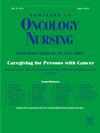Understanding the Influences of Cervical Screening Attendance among Women of Low Socioeconomic Position Using the Integrated Screening Action Model: A Qualitative Study
IF 2.3
4区 医学
Q1 NURSING
引用次数: 0
Abstract
Objectives
People of lower socioeconomic position have a higher incidence of cervical cancer and lower uptake of cervical screening. The Integrated Screening Action Model considers how an individual’s environment, capability, opportunity, and motivation influence screening engagement. This study explored the influences of attending cervical screening among women of low socioeconomic position living in Dublin, Ireland, between those who are underscreened and regularly screened.
Methods
Semistructured interviews were conducted with those who self-reported regularly attending screening or were underscreened, no university-level education, low-income employment or not working, aged 25 to 65 years, and living in Dublin. Participants were recruited via community organizations. A framework analysis was used to explore influences between regularly screened and underscreened participants.
Results
Sixteen participants were interviewed, and eight were underscreened. Regularly screened participants articulated their motivation to stay well, while underscreened participants appeared to avoid the potential of bad news, which was mediated by fear. Underscreened participants seemed to have limited social support and opportunity to consider screening, whereas regularly screened participants reflected that their peers supported them to attend, and in turn, they supported others (e.g., mothers being role models for daughters). The capability to attend screening was restricted for underscreened participants who often reported not knowing how to book a screening.
Conclusion
The study highlights varied barriers and facilitators between those who are underscreened and regularly attend screening. Social opportunity was a major influencing factor in promoting screening and should be considered when designing interventions to promote screening in the community. Communications on screening must use understandable language. Understanding what is important to women when promoting screening uptake is essential to develop interventions that reflect their needs.
Implications for Practice
Women appreciate reminders and trust information from health care professionals. Health care professionals may need training for opportunistic screening and to promote the availability of cervical screening in registered health care facilities.
利用综合筛查行动模型了解低社会经济地位妇女子宫颈筛查出勤率的影响:一项定性研究
目的:社会经济地位较低的人群宫颈癌发病率较高,宫颈筛查率较低。综合筛查行动模型考虑个人的环境、能力、机会和动机如何影响筛查参与。本研究探讨了生活在爱尔兰都柏林的社会经济地位较低的妇女参加宫颈筛查对未接受筛查和定期接受筛查的妇女的影响。方法:对那些自称定期参加筛查或未接受筛查、没有大学学历、低收入就业或没有工作、年龄在25至65岁、居住在都柏林的人进行半结构化访谈。参与者是通过社区组织招募的。框架分析用于探讨定期筛查和未筛查参与者之间的影响。结果:16名参与者接受了采访,8名未被筛选。定期接受筛查的参与者明确表达了他们保持健康的动机,而未接受筛查的参与者似乎避免了潜在的坏消息,这是由恐惧介导的。未接受筛查的参与者似乎只有有限的社会支持和考虑筛查的机会,而定期接受筛查的参与者反映,他们的同伴支持他们参加筛查,反过来,他们也支持其他人(例如,母亲是女儿的榜样)。未接受筛查的参与者参加筛查的能力受到限制,他们经常报告不知道如何预订筛查。结论:该研究强调了未接受筛查者和定期参加筛查者之间的各种障碍和促进因素。社会机会是促进筛查的一个主要影响因素,在设计促进社区筛查的干预措施时应予以考虑。筛选交流必须使用可理解的语言。了解在促进妇女接受筛查时什么对她们重要,对于制定反映她们需求的干预措施至关重要。对实践的启示:妇女欣赏提醒和信任来自卫生保健专业人员的信息。保健专业人员可能需要接受机会性检查方面的培训,并促进在注册保健设施提供子宫颈检查。
本文章由计算机程序翻译,如有差异,请以英文原文为准。
求助全文
约1分钟内获得全文
求助全文
来源期刊

Seminars in Oncology Nursing
Nursing-Oncology (nursing)
CiteScore
3.40
自引率
0.00%
发文量
68
审稿时长
45 days
期刊介绍:
Seminars in Oncology Nursing is a unique international journal published six times a year. Each issue offers a multi-faceted overview of a single cancer topic from a selection of expert review articles and disseminates oncology nursing research relevant to patient care, nursing education, management, and policy development.
 求助内容:
求助内容: 应助结果提醒方式:
应助结果提醒方式:


